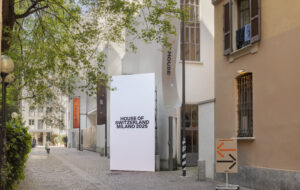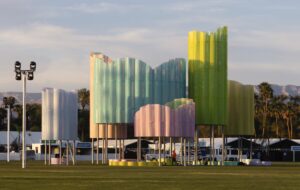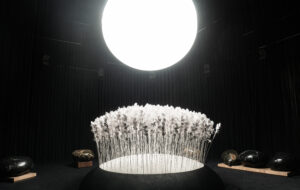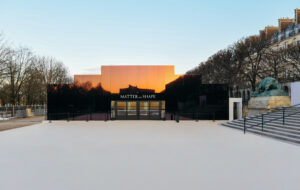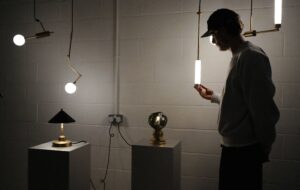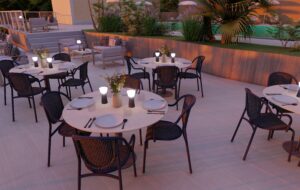


words Anna Bates
“Everything is like I wanted,” says Piet Hein Eek putting his hands behind his head. “I have my team, I have my place. I don’t have to travel a lot. I don’t have to talk too much. I just design. I do what I want.”
The 39-year-old Dutch furniture designer is sitting in his studio in the village of Geldrop, near Eindhoven, leaning back in his chair with the satisfied look of a man who has achieved what he set out to. The youngest of the Design Academy Eindhoven’s breed of conceptual designers, Eek’s work is a reaction against the way that his generation of graduates – including Hella Jongerius, Marcel Wanders, Jurgen Bey and Richard Hutten – were taught. While other Dutch designers were littering the country with one-line jokes, Eek set up his own manufacturing company, creating expensive, finely crafted pieces of furniture out of scrap wood and metal.
Eek’s studio is a maze of workrooms where craftsmen and women are busy sawing wood and soldering metal. Someone is singing along to My Girl in the background, and a couple of workers are knocking a football about in the sawdust. In the far corner is a showroom exhibiting a collection of Eek’s furniture, and by the entrance an enormous storage area contains finished products, stacked up on shelves that nearly reach the ceiling. It looks like a cross between Ikea and Santa’s workshop.
It has taken a while to find Eek. When I arrived I introduced myself to a worker, but he got a splinter in his hand and ran off to get a tissue. Eventually someone gestured me to the kitchen where I found a heavy-lidded man with a casual, sleepy demeanour making coffee.
“I don’t think ideas are important,” says Eek. “That’s the opposite to what we were told in school. Everything was focused on having a nice idea – Dutch design has a little bit of a joke in it, it’s the way of designing in Holland. I really disapprove of it. If you are creative you have 30 ideas a day, so why focus on one? If you don’t have ideas you shouldn’t be a designer. Instead of seeing it as a natural part of your job they are making it the most essential part.”
Eek fell out with most of his teachers at the Academy. “I always did my thing,” he says. “They brainwashed the students. If you are not strong, you think they’re right.” It was his generation that went on to form the ideas-based Droog design collective. Eek exhibited at one of the first Droog shows – before the exhibition acquired its name – but he turned his back on the scene when he saw the direction the collective was taking. He felt that Droog was merely a promotional exercise to get Dutch designers on the international scene, and he noticed that it hardly sold any of the designers work. Instead he chose to set up his own manufacturing base and exhibit his furniture in art galleries.
Graduating in 1990, Eek gained attention for his exam project Scrap Wood Cupboards. He sold all the cupboards and used the money to set up his practice. Since then, he has been developing a method of designing what he calls “free work”. “It’s like art,” he says. He works like a sculptor, carefully selecting materials on the basis of their appearance. As well as furniture, he has also designed boat interiors, a line of bakeries and a chest for denture storage. It is a small-scale practice based on traditional craftsmanship rather than a production line. Each of his almost one hundred designs is produced in the studio’s 2,500sq m workshop by his 28 workers.
Eek’s fascination with old materials came about when he restored a cupboard for his sister. He was looking around a building site and he thought the old wood looked nicer than the new. It’s a case of aesthetics rather than ideology. “There’s nothing ecological about it,” Eek says. “I just liked it – it was old and different.” Now old wood in Holland is more expensive than new wood (Eek likes to think this is due in some part to his success).
Eek’s “free work” fits into three projects. The first was the Doors Project – a series of cupboards constructed around old doors. “I like normal traditional things,” he says. “Things that are not even traditional in terms of design. Things that are so normal nobody sees them.” A shower and toilet cubicle are positioned on the top shelf in his workshop, a monument to the bland “everyday” furniture he grew up with. His studio became overcrowded with doors too big to make cupboards out of, so he started a larger project to find a use for them – The Garden House project. Most of the collection is constructed out of a mishmash of reclaimed wood, metal, windows and doors.
Since 2000, Eek has been designing pieces for his Nature and Waste Materials project, in which pieces are made from leftover off-cuts of the scrap material he uses to make his other projects. The pieces are put together simply by seeing which pieces fit where – like a three-dimensional jigsaw puzzle. Where Droog designers laboured over an idea, Eek gives value to his furniture by toiling over each step of the production.
“I like the idea that everything we do deals with labour,” Eek says. “That’s the story. It’s the opposite of what everybody does, which is the reason why we do it. I formed processes that took a deliberately long time,” he continues. “By repetition, you get something – a texture. I used the most labour-intensive way of using material that is worth nothing.” It is clear how many hours have been spent slotting pieces of rejected material together, giving the furniture a slightly haunted appearance.
As well as reacting against the Droog ethos, Eek sees his work as a response to modernist ideals of mass production, and specifically the polished work of the Eighties and Nineties. He describes the two decades as “the worst we have ever had creatively.” “Normally creativity is high when there is confusion and problems, but the only problem then was how to get more money for less work,” he adds.
Eek’s Aluminium Chair of 1993, made from a sheet of aluminium that is cut and folded, looks uncharacteristically sleek, until a closer look reveals its rough, handmade edges. In fact, it’s reminiscent of Jean Prouvé’s work, and Eek confesses how much he admires the French designer’s heavily engineered furniture. “When designers didn’t exist, architects and engineers designed,” he says, showing me a cabinet in his showroom housing a collection of homemade hinges, displayed like ornaments.
To Eek, exposing all the evidence of an object’s construction is the aim, distinguishing his work from what he describes as the “stylistic minimalism” that has been fashionable for so long. “A table without details has sneaky details that you don’t see. They put maximum effort into achieving that look. It was a fashion,” he says. “I don’t think it was a very good one.”
Eek aims to grow his workshop by five to ten people each year, and he is currently planning a move to bigger premises. Although he has a production line in place, the workers are more like a community of artisans than an assembly line, each working on one product until it is finished.
The clinks and clunks of machinery come to a halt and there is a sudden flurry of activity in the adjacent room. The workers congregate around a huge scrap-wood table, halting their work for a break and a snack, and the smell of coffee momentarily replaces the smell of metal and sawdust.
Boek, a book on Piet Hein Eek by Max Fraser, published by Uitgeverij De Boekenmakers, is out now


